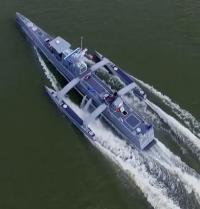 Two years ago we posted about the ASW Continuous Trail Unmanned Vessel (ACTUV), Sea Hunter, a 132′ long autonomous drone trimaran designed to track enemy submarines, being developed by the US Navy. The unmanned ship reached a major milestone recently after sailing autonomously from San Diego to Pearl Harbor, Hawaii, and back.
Two years ago we posted about the ASW Continuous Trail Unmanned Vessel (ACTUV), Sea Hunter, a 132′ long autonomous drone trimaran designed to track enemy submarines, being developed by the US Navy. The unmanned ship reached a major milestone recently after sailing autonomously from San Diego to Pearl Harbor, Hawaii, and back.
While Sea Hunter may have sailed autonomously to Hawaii and back, it was not unattended. Crew members from an escort vessel boarded the ship for short durations to check electrical and propulsion systems. For most of the voyage, however, the ship was unmanned.
As we noted in our previous post, the US Navy is facing the challenge of countering the potential threat from a new generation of diesel-electric submarines. The idea was to counter this threat by using a fleet of unmanned drone ships to detect and continuously track diesel-electric submarines. Since our first post, however, the Sea Hunter’s designation has been changed to Medium Displacement Unmanned Surface Vessel (MDUSV). It appears that the mission of the ship has been made considerably broader than strictly Anti-Submarine Warfare.
One question remains. When there are scores of over 130′ long autonomous ships deployed on the oceans, who has the right of way? The Navy has a hard enough time avoiding collisions with dozens of people on the bridge of their ships. How will they manage an autonomous fleet?

Since when does “right of way” concern the Navy?
Sadly too often it hasn’t meant much. After killing 17 sailors in two collisions, let’s hope that they gain a greater appreciation of the meaning of the meaning of the phrase “right of way.” Let’s hope they learn the lesson before sending out autonomous ships.
My guess is that autonomous vessels will do a better job with right of way, the same as general aviation (think low-skill pilots with high performance aircraft) would do better if aircraft were under fully automatic control. CFIT is SOP with people in charge. People are an impediment in close encounters by ships and aircraft.
Ships and aircraft: both have the blessing of being in a far simpler environment than automobiles.